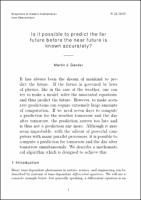| dc.contributor.author | Gander, Martin J. | |
| dc.contributor.editor | Munday, Sara | |
| dc.contributor.editor | Jahns, Sophia | |
| dc.date.accessioned | 2019-12-18T10:13:23Z | |
| dc.date.available | 2019-12-18T10:13:23Z | |
| dc.date.issued | 2019-12-18 | |
| dc.identifier.uri | http://publications.mfo.de/handle/mfo/3693 | |
| dc.description.abstract | It has always been the dream of mankind to predict
the future. If the future is governed by laws
of physics, like in the case of the weather, one can
try to make a model, solve the associated equations,
and thus predict the future. However, to make accurate
predictions can require extremely large amounts
of computation. If we need seven days to compute
a prediction for the weather tomorrow and the day
after tomorrow, the prediction arrives too late and
is thus not a prediction any more. Although it may
seem improbable, with the advent of powerful computers
with many parallel processors, it is possible to
compute a prediction for tomorrow and the day after
tomorrow simultaneously. We describe a mathematical
algorithm which is designed to achieve this. | en_US |
| dc.language.iso | en | en_US |
| dc.publisher | Mathematisches Forschungsinstitut Oberwolfach | en_US |
| dc.relation.ispartofseries | Snapshots of modern mathematics from Oberwolfach;2019,21 | |
| dc.rights | Attribution-ShareAlike 4.0 International | * |
| dc.rights.uri | http://creativecommons.org/licenses/by-sa/4.0/ | * |
| dc.title | Is it possible to predict the far future before the near future is known accurately? | en_US |
| dc.type | Article | en_US |
| dc.identifier.doi | 10.14760/SNAP-2019-021-EN | |
| local.series.id | SNAP-2019-021-EN | en_US |
| local.subject.snapshot | Numerics and Scientific Computing | en_US |
| dc.identifier.urn | urn:nbn:de:101:1-2019121815240680561100 | |
| dc.identifier.ppn | 1685944949 | |


